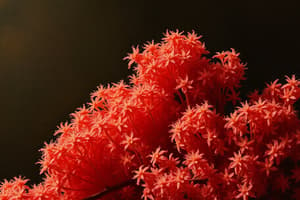Podcast
Questions and Answers
What is the chromosome number of rice?
What is the chromosome number of rice?
- 2n = 22
- 2n = 24 (correct)
- 2n = 20
- 2n = 26
Which of the following statements accurately describes the protein content in rice?
Which of the following statements accurately describes the protein content in rice?
- Milled rice protein content is usually 10-12%.
- Rice has the same protein content as barley.
- Rice typically has a protein content of 6-7%. (correct)
- Rice contains more protein than wheat.
Which rice species is primarily cultivated in tropical West Africa?
Which rice species is primarily cultivated in tropical West Africa?
- Oryza nivoroo
- Oryza glaberrima (correct)
- Oryza sativa
- Oryza rufipogen
Which region is suggested as a probable center of origin for cultivated rice?
Which region is suggested as a probable center of origin for cultivated rice?
What is the main use of rice bran?
What is the main use of rice bran?
Which of the following by-products of rice milling is used for insulation?
Which of the following by-products of rice milling is used for insulation?
How much oil can be recovered from rice bran?
How much oil can be recovered from rice bran?
What event is considered the oldest sample of rice grains?
What event is considered the oldest sample of rice grains?
Which of the following is NOT a sub-species of rice (Oryza sativa)?
Which of the following is NOT a sub-species of rice (Oryza sativa)?
How is rice typically categorized in terms of energy content?
How is rice typically categorized in terms of energy content?
Flashcards are hidden until you start studying
Study Notes
Rice Overview
- Botanical name: Oryza sativa L.
- Chromosome count: 2n = 24
- Major energy source: staple food for a significant portion of the global population.
- Protein content: 6-7% in milled rice, lower than wheat but with high biological value.
- Fat content: low at 2.0-2.5%, much of which is lost during milling.
- B vitamins: rice contains as much as wheat.
- Calcium content: low in rice.
- By-products of milling have various uses.
Rice By-products
- Rice bran: utilized as cattle and poultry feed and for oil extraction; comprises about 8% of paddy weight and contains 15-20% oil.
- Recoverable oil from rice bran is approximately 15%.
- Global rice bran oil production ranges between 1-1.4 million tonnes, with India contributing 0.7-0.9 million tonnes.
- Rice hulls: repurposed for insulation materials, cement, cardboard, and as poultry litter.
- Rice straw: serves as cattle feed and winter litter.
Cereals Definition
- Definition: crops in the family Gramineae grown for edible starchy grains called caryopsis.
- Etymology: the term 'cereals' derives from Ceres, the Roman Goddess symbolizing the 'Giver of Grains'.
Origin of Rice
- Out of 24 species of the genus Oryza, only Oryza sativa and Oryza glaberrima are cultivated.
- Oryza sativa: cultivated in all rice-producing areas; Oryza glaberrima is specific to tropical West Africa.
- Relatives of O. sativa include wild perennial O. rufipogen and annual O. nivoroo.
- Relatives of O. glaberrima include wild perennial O. longistominata and annual O. barthii.
- Oldest rice grains excavated at Hastinapur, India, dated to 1000-750 B.C.
- Suggested centers of origin:
- Southwest Himalayas indicates diverse types and probable origin.
- Studies by De Candolle (1886) and Watt (1862) mention South India as a center of origin.
- Vavilov proposed India and Myanmar as major centers for cultivated rice.
- D. Chatterjee (1948) suggested two centers of origin: Southeastern Asia (including India, Myanmar, Thailand) and West Africa.
Genetic Classification
- Rice varieties classified into three sub-species:
- Indicas: traditional tropical varieties characterized by:
- Long duration growth cycle and photosensitivity.
- Tall, weak stem structure and susceptibility to lodging.
- Lower responsiveness to heavy fertilization.
- Indicas: traditional tropical varieties characterized by:
Studying That Suits You
Use AI to generate personalized quizzes and flashcards to suit your learning preferences.




